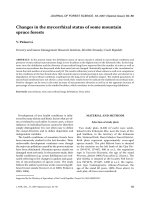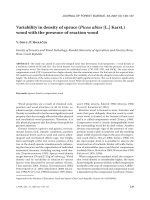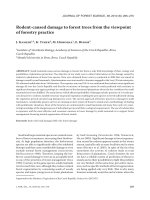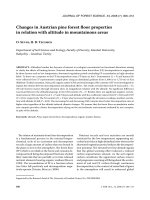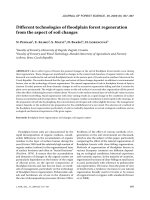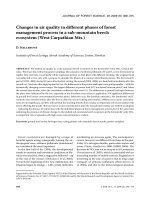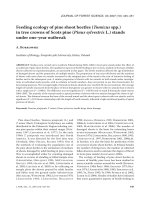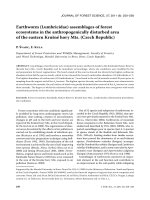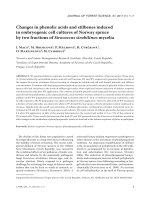Báo cáo lâm nghiệp: "Changes in Austrian pine forest floor properties in relation with altitude in mountainous areas" pdf
Bạn đang xem bản rút gọn của tài liệu. Xem và tải ngay bản đầy đủ của tài liệu tại đây (271.91 KB, 8 trang )
306 J. FOR. SCI., 54, 2008 (7): 306–313
JOURNAL OF FOREST SCIENCE, 54, 2008 (7): 306–313
e release of nutrients from litter decomposition
is a fundamental process in the internal biogeo-
chemical cycle of an ecosystem and decomposers
recycle a large amount of carbon that was bound in
the plant or tree to the atmosphere. e forest floor
(FF) which is overlaid on the forest soil contains de-
composed and being decomposed fractions of plant
litter materials that are partially or in time released
nutrient elements bearing organic residues (B
1990). e accumulation of FF is a function where
tree litter fall positively and decomposition nega-
tively operate (F, B 2000).
Nutrient recycle and tree nutrition are mostly
restricted by the low temperature suppressing mi-
crobial activities at high altitudinal sites whereas the
shortened vegetation period reduces the decomposi-
tion potential. e elevated tree line altitude signals
that the global warming effect induced a reduced
carbon sequestration amount. As the soil organic
carbon constitutes the uppermost carbon reserve
and progressive warming will bring about the evolve-
ment of soil and FF carbon through continuous
decomposition, in the context of raised fuel oil gases
in the atmosphere will result in enhanced global
Supported by the Research Fund of e University of Istanbul, Project No. 228/29042004.
Changes in Austrian pine forest floor properties
in relation with altitude in mountainous areas
O. S, H. B. T
Department of Soil Science and Ecology, Faculty of Forestry, Istanbul University,
Bahçeköy – Istanbul, Turkey
ABSTRACT: Altitudinal studies has become of interest to ecologists concentrated on functional alterations aiming
to clarify the effects of limiting factors. Nutrient element release from forest floor (FF) decomposition is suppressed
by those factors such as low temperature, shortened vegetation period concluding FF accumulation at high elevation
fields. To draw out a response to the FF decomposition issue, FF layers as leaf + fermentation (L + F) and humus (H)
were collected from 37 representative sample plots along an altitudinal gradient (from 1,400 m to 1,710 m) on Kaz
(Balikesir-Turkey) mountain. Mass, pH, organic matter (OM) and total nitrogen (Nt) contents of FF were investigated to
explain the relation between decomposition and altitudinal effects. e results revealed that total FF mass and (L + F),
(H) sub-fraction masses through elevation show an insignificant relation with the altitude. No significant difference
was found between the altitudinal groups in the OM content of L + F. Besides there are significant negative correla-
tions between OM contents (%) of L + F and H layers and altitude with the coefficient values 0.342 (P < 0.05) and 0.597
(P < 0.01), respectively. e Nt content of L + F layer also increases through the elevation revealing a medium correla-
tion with altitude (0.368; P < 0.05). e increasing Nt and decreasing OM contents show better decomposition rates at
higher sites regardless of the altitude induced climatic changes. We assume that the forest floor accumulation under
tree canopies provides a better decomposition relying on the microclimatic environment mediated by tree canopies,
in spite of the altitude.
Keywords: altitude; Pinus nigra; forest floor; decomposition; organic matter; humus
J. FOR. SCI., 54, 2008 (7): 306–313 307
warming. Studies over the past few decades show
a strong consensus on the release of soil organic
carbon through the increasing temperature and
they summarized a positive correlation between the
two factors. e potential net transfer of CO
2
to the
atmosphere was also considered in the perspective
of the inequality of decomposition and net primary
production (C et al. 2002).
Under similar environmental conditions the struc-
tural characteristics of stands (age, mean dbh, basal
area) and wood production lead to differences in the
spatial and temporal patterning of inorganic nitro-
gen pools in organic horizons (A et al. 2005)
such as quality of soil organic matter with regard to
N mineralization (C et al. 2000). Nitrogen and
carbon cycles are initiated by decomposition of FF
material under harsh environmental conditions in
the high elevation surroundings. Since the decom-
position conditions are inappropriate, the litter
on the FF is expected to be accumulated, which is
supposed to be a threat to the site productivity due
to the immobilization of nutrients in the litter or
liberated by the precipitation (D et al. 1998).
Litter decomposition, one of the most vital processes
of forest ecosystems, is controlled essentially by soil
organisms, environmental conditions and by the
characteristics of litter (U et al. 2000). Mineral-
ization of N contained in dead organic matter, while
providing energy for microbial metabolism, makes
inorganic N available for plant uptake (P et al.
2003). Some studies point out that the elevation has
a remarkable effect on microbial activities (K,
S 1998; D et al. 2001) taking into account
nitrogen mineralization and nitrification rates while
others support the irrelevance of temperature on
the microbial activity in terms of the microbial res-
piration rate (N, K 2006). us in
this study we aimed to elucidate the interactions in
mountainous conditions in the case of FF accumu-
lation and decomposition rates under the effects of
ecosystem components such as altitude and altitude
induced climate on the FF characteristics.
Site characteristics
Our study plots were chosen on Kaz Mountain
on the Biga Peninsula, which is situated between
the parallels 26°48'45'' and 26°54'00'' and longitudes
39°46'30'' and 39°49'45''. e Biga Peninsula consists
of two main mountainous massifs, Biga Mountain in
the northern part and Kaz Mountain in the south-
ern part. At the higher altitude from 1,400 m at Kaz
Mountain there arise three peaks: at Bayramiç as-
pect, in the north, Babadağ (1,767 m), and at Edremit
aspect, in the south, Sarikiz (1,726 m) and Karataş
(1,774 m) with the highest summit.
According to long-term average values provided
by the Biga Peninsula meteorological station, annual
precipitation is 889.7 mm and 1,340 mm; mean tem-
perature is 12.9°C and 8.8°C at 400 m and 1,400 m
elevation, respectively (Table 1).
According to the Edremit meteorological station
located on the southern aspect of the mountain the
site has a definite summer drought with the annual
mean temperature 16.4°C and with the total annual
precipitation amounting to 697.2 mm.
e Biga Peninsula has a large variety of plant
diversity where 1,000 species were distinguished
and published being searched from D (1984).
Two main elevation-climate belts were assigned
rising from red pine (Pinus brutia L.) to Austrian
pine (Pinus nigra Arnold) which were also divided
into sub-belts such as lower, mid and upper. Besides,
beech (Fagus orientalis Lipsky) and fir (Abies born-
mülleriana Mattf.) stands were detected in the val-
leys and chiefly on the northern steep slopes where
Table 1. Data on annual, 5 summer months and January mean temperatures (
o
C) and precipitation (mm) from the Biga
Peninsula meteorological station
Elevation
(m)
Annual
5 summer
months
(V + V I+ VII +
VIII + IX)
January
precipitation
(mm)
temperature
(°C)
precipitation
(mm)
temperature
(°C)
precipitation
(mm)
temperature
(°C)
600 960.5 12.2 153.3 18.9 141.0 3.5
800 1,031.2 11.5 163.2 18.1 153.2 3.0
1,000 1,134.4 10.6 181.6 17.2 169.0 2.3
1,200 1,237.6 9.7 199.0 16.3 184.8 1.6
1,400 1,340.9 8.8 218.8 15.3 200.5 0.8
(K, S 1997)
308 J. FOR. SCI., 54, 2008 (7): 306–313
it is humid with cloudy and foggy microclimate
(K, S 1997). In addition, the study
material and some specific properties of the study
site are given in Table 2.
Sampling and analysis
e lower elevations of Kaz Mt. were presented by
S (2003) revealing the records essential for the
forthcoming studies at the peak of the mountain. e
summit of the mountain takes up an approximately
4,000 ha area representing our study site, where the
main tree species is black pine and which is mana-
ged under the administration of the Kaz Mountain
National Park Directorate. At the study site totally
74 forest floor layer samples as leaf + fermentation
(L + F) and humus (H) were collected from 37 sample
plots to represent the whole study area. e sampling
areas were selected by paying attention to the closed
canopy cover within composing 2–3 sub-samples at
a width 50 × 50 cm
2
where the sampling points were
chosen randomly. Coarse woody debris were removed
from forest floor samples, containing the roots, and
then air dried and ground to prevent further fermen-
tation. Layer samples were weighed after oven dried
at 65°C for 24 hours. Actual pH was determined
with a glass electrode of Hannas pH instrument in a
suspension of
1
/
5
ml soil solution with distilled water
Table 2. Some properties of the study site
Site properties
(kg/(0.05 m × 1 m
2
))
Altitudinal ranges
1,400–1,500 m
(n = 11)
1,500–1,600 m
(n = 9)
1,600–1,700 m
(n = 11)
> 1,700 m
(n = 6)
Volume weight 38.14 37.44 54.06 61.4
Fine soil weight 24.95 24.28 33.13 34.63
Skeleton 13.19 13.17 20.93 26.77
Soil Nt 0.07 0.08 0.064 0.07
Soil C
org
1.52 1.77 1.12 0.96
Sand 16.78 16.38 20.08 26.28
Silt 2.72 2.3 3.34 3.28
Clay 3.87 3.75 4.52 4.05
pH (min.–max.) 4.27–7.33 4.42–5.64 4.85–6.63 4.63–6.52
Main rock 2 site Silicate, 9 site Gabro Gabro Gabro Gabro
Stand canopy cover 0.40–0.65 0.4–0.7 0.05–0.80 0.01–0.10
Stand age 95–227 47–211 36–57 19–34
Tree number/ha 213–1,175 250–875 59–1,625 55–299
(S, T 2007)
0
2,000
4,000
6,000
8,000
10,000
12,000
14,000
1400-1500m
1500-1600m
1600-1700m
>1700m
1400-1500m
1500-1600m
1600-1700m
>1700m
1400-1500m
1500-1600m
1600-1700m
>1700m
Altitude
Forest Floor Weight (gr/m
2
)
H L+F T
Fig. 1. Forest floor weight al-
terations in connection with the
altitude
Forest oor weight (g/m
2
)
1,400–1,500
1,500–1,600
1,600–1,700
> 1,700
1,400–1,500
1,500–1,600
1,600–1,700
> 1,700
1,400–1,500
1,500–1,600
1,600–1,700
> 1,700
Altitude (m)
H L + F T
J. FOR. SCI., 54, 2008 (7): 306–313 309
which was left to stand overnight and then shaken and
measured after an hour (G 1974). Organic mat-
ter content was determined by Loss on ignition method
(G 1974). e determination of total N was car-
ried out by Kjeldahl method at the Tecator Kheltec Auto
Analyzer 1030 (J 1962; G 1974). e sta-
tistical analysis was conducted in SPSS 11.0 version and
within the analysis we compared the altitudinal groups
among each other and also regression and correlation
analysis were done to find out the effect of altitude.
RESULTS
Weights of forest floor layer
Since the tree numbers/ha decrease markedly with
increasing elevation, the comments related to kg/ha
unquestionably give consequences implying that all
the weight parameters decrease as the altitude in-
creases. So the evaluations concerning weight were
done according to the g/m
2
unit. e average values of
total FF weights range between 1,856 and 3,098 g/m
2
at elevations 1,400–1,500 m and > 1,700 m, respec
-
tively (Table 3). e weight measurement (g/m
2
) re-
sults show that the weight variations of FF and L + F
and H sub-fractions through elevation are insignifi-
cant (Table 4). Both the L + F and H layers and the
total weights reflect an undulating graph (Fig. 1).
Organic matter contents of forest floor layers
A negative relation was detected between OM
contents (%) of L + F and H layers and elevation
significant at P < 0.05 and P < 0.01 levels with the
Table 3. Tukey’s HSD variance analysis test (P < 0.05) of weight, total nitrogen (Nt), organic matter (OM) contents and
pH (H
2
O) of forest floor layers
Altitudinal ranges
Forest floor layers
1,400–1,500 m
(n = 11)
1,500–1,600 m
(n = 9)
1,600–1,700 m
(n = 11)
> 1,700 m
(n = 6)
Weight L + F (g/m
2
) 1,856
a
3,001
a
2,160
a
3,098
a
Weight H (g/m
2
) 2,166
a
1,732
a
848
a
1,768
a
Weight total (g/m
2
) 4,023
a
4,732
a
3,132
a
4,866
a
Nt L + F (%) 0.873
a
0.889
a
0.907
a
1,265
b
Nt L + F (g/m
2
) 15.2
a
27.1
ab
19.1
a
41.9
b
Nt humus (%) 0.846
a
0.786
a
0.777
a
0.559
a
Nt humus (g/m
2
) 16.1
a
14.4
a
5.6
a
9.1
a
OM L + F (%) 85.0
a
81.0
a
78.4
a
76.3
a
OM L + F (g/m
2
) 1,551
a
2,475
a
1,684
a
2,337
a
OM humus (%) 54.4
a
43.5
a
37.0
ab
20.9
b
OM humus (g/m
2
) 1,042.0
a
814.0
ab
305.2
b
319.4
b
pH L + F (H
2
O) 4.52
a
4.16
a
4.44
a
4.52
a
Ranges (3.52–5.54) (3.99–4.33) (3.99–4.85) (4.11–5.00)
pH humus (H
2
O) 5.06
a
4.48
a
5.01
a
4.95
a
Ranges (4.14–6.80) (3.98–5.09) (4.52–5.56) (4.49–5.72)
Table 4. Correlation coefficients and significance levels of forest floor layers with altitude
Variables L + F H Total
Weight (g/m
2
) 0.234 –0.275 –0.012
Organic matter (%) –0.342* –0.597**
Organic matter (g/m
2
) 0.17 –0.543** –0.092
Total nitrogen (%) 0.368* –0.203
Total nitrogen (g/m
2
) 0.360* –0.409* 0.15
pH –0.001 –0.037
**0.01 significance level, *0.05 significance level
310 J. FOR. SCI., 54, 2008 (7): 306–313
coefficient values –0.342 and –0.597, respectively,
revealing poor and moderate relation levels (Ta-
ble 4). Relying on the results it can be concluded
that the elevation has an adverse effect on OM
contents of the mentioned FF layers, which is
also indicated by an advantageous nutrition sta-
tus. Furthermore, the linear models established
between OM contents (%) of L + F and H layers
and elevation have the R
2
values 0.117 and 0.357,
respectively (Table 5).
Total nitrogen contents of forest floor layers
Positive relations were detected between Nt
contents (% and g/m
2
) of L + F layer and altitude
at a P < 0.05 significance level with the coefficient
values 0.368 and 0.360, respectively (Table 4). The
R
2
values of linear models established between Nt
contents (% and g/m
2
) of L + F layer and altitude
are 0.135 and 0.130, respectively (Table 5). While
the relation between Nt content (%) of H layer
and altitude was insignificant, the nitrogen con-
tent values per unit area (1 m
2
) were negatively
significant at a P < 0.05 level with the coefficient
value –0.409 whereas the relation model has the
R
2
value 0.167.
Reaction of forest floor
e average pH values of L + F and H layers show
a wavy sequence which decreases by the height of
1,500 m and then increases (Fig. 2); showing insig-
nificant differences (Table 4). e min. and max. pH
values for L + F and H layers are between 3.52–5.54
and 3.98–6.80, respectively (Table 3). e pH results
for H demonstrate a high variation with a higher
decrease at 1,600 m elevation, while L + F show a
more constant contribution along the altitudinal
gradient (Fig. 2). e decreased pH might be caused
by reduced precipitation from the elevation 1,650 m,
but the probability should be evidently corrected
by the implication of more frequent meteorological
measurements.
DISCUSSION
Weights of forest floor layer
K (1997) recorded an average weight of
4,072.75 g/m
2
ranging between 2,951–4,714 g/m
2
at
≥ 1,400 m at Aladağ Mt., Bolu with an upper range of
our study. G (2006) found that while there is an
insignificant relation between L and H layer weights,
Table 5. Significant linear models and the coefficient of correlation between forest floor properties and altitude
Variables
Model components Variant estimates
R
2
F value significance coefficient factor
L + F organic matter (%) 0.117 4.65 0.038 126.796 –0.0293
L + F Nt (%) 0.135 5.47 0.025 –0.4547 0.0009
L + F Nt (g/m
2
) 0.130 5.22 0.028 –70.706 0.0599
Humus organic matter (%) 0.357 19.39 0.000 190.063 –0.0946
Humus organic matter (g/m
2
) 0.294 14.61 0.001 5,385.06 –3.0078
Humus Nt (g/m
2
) 0.167 7.03 0.012 67.7034 –0.0358
3.00
3.50
4.00
4.50
5.00
5.50
6.00
6.50
7.00
1,300 1,400 1,500 1,600 1,700 1,800
Altitude (m)
L + F pH
3.00
3.50
4.00
4.50
5.00
5.50
6.00
6.50
7.00
1,300 1,400 1,500 1,600 1,700 1,800
Altitude (m)
Humus pH
Fig. 2. pH alteration due to elevation at forest floor layers
J. FOR. SCI., 54, 2008 (7): 306–313 311
a positive relation exists between F layer and altitude
(P < 0.01). Similarly G and H (2006)
put forward that the FF amount does not follow a
linear curve along the altitude relying on studies
conducted in the Appalachian Mountains. e rela-
tion between FF weight and altitude differs due to
various causes among which the prevailing climate
and microbiological activities could be pronounced
particularly. G and H (2006) stated that
the determination of decomposition rate is chiefly
possible by controlling the microorganism activi-
ties which would be the source of overaccumulation
of FF layers within the same tree litter fall addition
conditions.
Organic matter and total nitrogen contents
Oppositely to our findings D and Š
(2002) observed a highly accumulated organic layer
above the mineral soil below the altitude ~1,510 m
which was the treeline for the western Carpathi-
ans where the treeline altitude is very close to our
study area. M (1974), and I and Ç
(1974) charged the suppressed decomposition situ-
ation to the anatomy of needles in accordance with
L et al. (2004), who recorded that 31.7% of
the initial mass was still remaining after 2 years for
pine. Besides V and C (2001) recorded
that in boreal forests where cold climatic conditions
prevail spruce forests have indigestible forest floor
within high C:N and low lignin:N ratios and modest
soluble nitrogen content. In our study we recorded
organic matter contents between 85.0–76.3% and
54.4–20.9% in L + F and H layers at the altitudinal
order (Table 3). OM content of H layer shows a
significant decrease along the altitude but the L + F
layer does not show a distinctive decrease. Accord-
ing to U et al. (2000) the rate of decomposition
was significantly correlated with the initial nutrient
concentration and material with higher C:N ratios
had a longer duration of immobilization and in turn
a slower release phase. is result helps to explain
the relation between tree nutrition and fresh needle
total nitrogen content. Our findings concerning total
nitrogen (%) contents of L + F layers (Table 3) reveal
similarity with N and K (2006), who
emphasized that among the nutrients measured,
only the total organic N concentration significantly
increased with elevation in the soil organic layer.
Oppositely (G 2000) stated that the soils of
upper elevations are mainly characterized by the
absence of N for biological demands. G (2006)
recorded that the total nitrogen content of forest
floor demonstrated the ranges between 0.58–0.66%
and 1.15–1.32% that due to increased elevation from
335–560 m to 1,570–1,670 m respectively, while in
our study site the Nt (%) content of L + F and H lay-
ers of forest floor demonstrated the value intervals
between 0.873–1.265 and 0.846–0.559% respectively
at elevations 1,400–1,500 m and > 1,700 m (Table 3).
Contrary to the above-mentioned authors our results
demonstrate that the altitude did not have an impres-
sive effect on decomposition.
CONCLUSION
e forest floor layer has completely covered the
whole area up to 1,650 m elevation, then stands
constitute from individually distributed trees. At the
upper elevations litter gathered from immediately
below the tree canopies. Above the tree line the
morphology of tree structure is damaged, the total
unshed leaf amount decreased, less-shaded leaves of
trees increased and upon that the litter accumulation
amount is only slightly higher at the elevation above
1,700 m which is insignificant (Table 3). e weight
difference should be reasoned from the sampling
points which had to be taken from the canopy circle
– very close to the tree stem. It is known that under
low temperature climatic conditions a nutrient loss
from leaf material is quite slight (H, P 1999).
P (1997) reported the half decomposition time
as 3.5 years and M et al. (1999) claimed the
3-year decomposition rate between 13 and 57%. Our
findings reveal that unless the organic matter content
of L + F and H layer changes dramatically (Table 3)
but the total nitrogen of L + F increases, the forest
floor accumulation under tree canopies provides a
better decomposition relying on the microclimatic
environment mediated by tree canopies, in spite of
the altitude. Trees might retranslocate the nutrient
elements in circumspection to avoid nutritional limi-
tations at higher altitudes concluding lower nutrient
and organic matter contents in forest floor litter. at
argument has been challenged with the assumption
that the nutrient retranslocation requirement de-
creases due to an increased leaf:stem rate at higher
altitudes; causing to increased total nitrogen content
of L + F layer (K 1998) which is in agreement
with our conclusion. e knowledge for high altitu-
dinal lands needs to be achieved within time scale
monitoring and the effects of climate and microor-
ganism components through rising CO
2
fluxes.
R e fer e n c e s
AUBERT M., BUREAU F., VINCESLAS-AKPA M., 2005.
Sources of spatial and temporal variability of inorganic
312 J. FOR. SCI., 54, 2008 (7): 306–313
nitrogen in pure and mixed deciduous temperate forests.
Soil Biology & Biochemistry, 37: 67–79.
BRADY N.C., 1990. e Nature and Properties of Soils. New
York, Macmillan Publishing Co.: 621.
CÔTE L., BROWN S., PARE D., FYLES J., BAUHUS J., 2000.
Dynamics of carbon and nitrogen mineralization in relation
to stand type, stand age and soil texture in the boreal mixed
wood. Soil Biology & Biochemistry, 32: 1079–1090.
COŰTEAUX M.M., SARMIENTO L., BOTTNER P., ACEVE-
DO D., THIÉRY J.M., 2002. Decomposition of standard plant
material along an altitudinal transect (65–3968 m) in the
tropical Andes. Soil Biology & Biochemistry, 34: 69–78.
DAMES J.F., SCHOLES M.C., STRAKERK C.J., 1998. Litter
production and accumulation in Pinus patula plantations
of the Mpumalanga Province, South Africa. Plant and Soil,
203: 183–190.
DAVIS P.H., 1984. Flora of Turkey and the East Aegean Islands.
Volume 8. Edinburgh, University Press.
DILLY O., BARTSCH S., ROSENBROCK P., BUSCOT F.,
MUNCH J.C., 2001. Shifts in physiological capabilities of
the microbiota during the decomposition of leaf litter in a
black alder (Alnus glutinosa (Gaertn.) L.) forest. Soil Biology
& Biochemistry, 33: 921–930.
DOLEŽAL J., ŠRUTEK M., 2002. Altitudinal changes in com-
position and structure of mountain-temperate vegetation:
a case study from the Western Carpathians. Plant Ecology,
158: 201–221.
FISHER R.F., BINKLEY D., 2000. Ecology and Management of
Forest Soils. 3
rd
Ed. New York, John Wiley & Sons Inc.: 512.
GARTEN C.T. Jr., 2000. Nitrogen saturation and soil N avail-
ability in a high-elevation spruce and fir forest. Water, Air,
and Soil Pollution, 120: 295–313.
GARTEN C.T. Jr., HANSON P.J., 2006. Measured forest soil
C stocks and estimated turnover times along an elevation
gradient. Geoderma, 136: 342–352.
GÜLÇUR F., 1974. Physical and chemical analysis methods of soil.
University of Istanbul Pub. No. 1970, Faculty of Forestry Pub.
No. 201. Istanbul, Kutulmuş Matbaasi: 225. (In Turkish)
GÜNER Ş.T., 2006. Determination of growth – nutrition
relations along an elevational gradient of Scots pine (Pi-
nus sylvestris ssp. hamata) forests at Türkmen mountain
(Eskişehir, Kütahya). [Doctorate esis.] (In Turkish)
HART S.C., PERRY D.A., 1999. Transferring soils from high- to
low-elevation forests increases nitrogen cycling rates: climate
change implications. Global Change Biology, 5: 23–32.
IRMAK A., ÇEPEL N., 1974. Research on forest floor de-
composition and humification rates at some Austrian pine,
beech and oak stands. University of Istanbul Pub. No. 1973,
Faculty of Forestry Pub. No. 204. Istanbul, Press Taş Mat-
baasi: 48. (In Turkish)
JACKSON M.L., 1962. Soil Chemical Analysis. London, Con-
stable and Company Ltd.: 498.
KANTARCI M.D., SEVGI O., 1997. e relation between
regional site condition characteristics and tree, shrub spe-
cies’ contribution in Biga peninsula. University of Istanbul
Research Projects Unit Project No. 881/090896: 100. (In
Turkish)
KNOEPP J.D., SWANK W.T., 1998. Rates of nitrogen miner-
alization across an elevation and vegetation gradient in the
southern Appalachians. Plant and Soil, 204: 235–241.
KÖRNER C., 1998. A re-assessment of high elevation treeline
positions and their explanation. Oecologia, 115: 445–459.
LORENZ K., PRESTON C.M., KRUMREI S., FEGER K.H.,
2004. Decomposition of needle/leaf litter from Scots pine,
black cherry, common oak and European beech at a con-
urbation forest site. European Journal of Forest Research,
123: 177–188.
MILLAR C.S., 1974. Biology of plant litter decomposition.
In: Decomposition of Coniferous Leaf Litter. Volume 1.
London, New York, Academy Press: 105–128.
MOORE T.R., TROFYMOW J.A., TAYLOR B., PRESCOTT
C., CAMIRE C., DUSCHENE L., FYLES J., KOZAK L.,
KRANABETTER M., MORRISON I., SILTANEN M.,
SMITH S., TITUS B., VISSER S., WEIN R., ZOLTAI S.,
1999. Litter decomposition rates in Canadian forests.
Global Change Biology, 5: 75–82.
NIKLIŃSKA M., KLIMEK B., 2006. Effect of temperature
on the respiration rate of forest soil organic layer along an
elevation gradient in the Polish Carpathians. Biology and
Fertility of Soils, 43: 511–518.
PAUSAS J.G., 1997. Litter fall and litter decomposition in
Pinus sylvestris forests of the eastern Pyrenees. Journal of
Vegetation Science, 8: 643–650.
PEREZ A.C., ARMESTO J.J., TORREALBA C., CARMONA
M.R., 2003. Litterfall dynamics and nitrogen use efficiency
in two evergreen temperate rainforests of Southern Chile.
Austral Ecology, 28: 591–600.
SEVGI O., 2003. Altitudinal nutrition growth relations of black
pine (Pinus nigra Arnold) at Bayramiç forest enterprise (Kaz
Mountains). University of Istanbul Institute of Science.
[Doctorate esis.] 221. (In Turkish)
SEVGI O., TECIMEN H.B., 2007. Growth – nutrition rela-
tions of Austrian pine (Pinus nigra Arnold) forests at upper
(1,400 m–1,750 m) mountainous part of Kaz Mountains.
University of Istanbul Research Projects, Unit Project No.
228/29042004: 160. (In Turkish)
USMAN S., SINGH S.P., RAWAT Y.S., BARGALI S.S., 2000.
Fine root decomposition and nitrogen mineralisation pat-
terns in Quercus leucotrichophora and Pinus roxburghii
forests in central Himalaya. Forest Ecology and Manage-
ment, 131: 191–199.
VANCE E.D., CHAPIN III F.S., 2001. Substrate limitations
to microbial activity in taiga forest floors. Soil Biology &
Biochemistry, 33: 173–188.
Received for publication December 25, 2007
Accepted after corrections April 27, 2008
J. FOR. SCI., 54, 2008 (7): 306–313 313
Změny nadložního humusu v závislosti na nadmořské výšce pod porosty
borovice černé v horských oblastech
ABSTRAKT: Studie zabývající se funkčními změnami v závislosti na nadmořské výšce za účelem objasnění efektu
limitních faktorů jsou dnes ve středu zájmů ekologů. Uvolňování nutričních prvků je zajišťováno rozkladem nadlož-
ního humusu, ve vyšších polohách závisí na následujících faktorech: nízké teploty, krátká vegetační doba, konečná
akumulace nadložního humusu. K získání odpovědi na otázku rozkladu nadložního humusu v jednotlivých vrstvách
– listy a drť (L+F) a humusové vrstvy (H) – byly v pohoří Kaz sebrány vzorky na 37 reprezentativních plochách
napříč výškového gradientu (od 1 400 m do 1 710 m). Za účelem odhalení vztahu rozkladu nadložního humusu na
nadmořské výšce byla sledována váha nadložního humusu, jeho reakce, podíl organické hmoty a celkový obsah dusí-
ku. Výsledky studia nadložního humusu neprokázaly statisticky významný vliv nadmořské výšky na váhové změny
jednotlivých subfrakcí (L + F), (H). Ačkoliv obsah organické hmoty v L + F a H vrstev se dramaticky nemění, zvýšený
celkový obsah dusíku z L + F můžeme vysvětlit silnějšími rozkladnými procesy v závislosti na mikroklimatických
podmínkách porostu.
Klíčová slova: nadmořská výška; Pinus nigra; nadložní humus; rozklad; organická hmota; humus
Corresponding author:
D. O S, Istanbul University, Faculty of Forestry, Department of Soil Science and Ecology,
TR-34473 Bahçeköy – Istanbul, Turkey
tel.: + 90 212 226 11 00 (25299), fax: + 90 212 226 11 13, e-mail:
